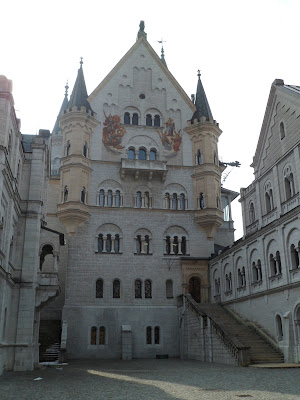Murder has actually nothing to do with our weekend, but an unexplained death that happened over a century ago has got the wheels in my brain churning with suspicion.
Yesterday we joined an organized USO tour to the "Fairy Tale Castles" in Bavaria. The two castles: Hohenschwangau and Neuschwanstein were both homes of Bavaria's King Ludwig II. Hohenschwangau was his family's summer getaway from Munich, but Neuschwanstein was his own crazy, indulged project. Ludwig II took the throne at age 18 after his father (Maximillian II) died. His reign was fairly uneventful, and was mainly comprised of intense taxation of his people to fund his wildly eccentric, fairy tale inspired castles, of which, Neuschwanstein is the most recognized.
In fact, you would recognize Neuschwanstein even if you'd never been there before. How? Walt Disney used Castle Neuschwanstein as his inspiration when designing Cinderella's Castle in Disneyland. Neuschwanstein was also shown as Baron von Bomburst's castle in Chitty Chitty Bang Bang.
Ludwig II is often referred to as "Mad King Ludwig" due to his very eccentric personality, ideas and habits. His younger brother, Otto, was actually declared mentally ill, so when King Ludwig's reign really started to get out of hand, it was almost too easy for doctors to extend the mental illness diagnosis to the King and depose him.
This is where it gets good. The day after King Ludwig was deposed, he was forcefully taken to Munich. The next day, his body and the body of the doctor who initiated his deposition, were found in a nearby lake. To this day no one has any idea whether this was a suicide, a murder, a drunken brawl...?
Dun, dun, duuuuuuunnnn!!!
Oo, that was a good one. I spent the entire bus ride home coming up with my own theories on King Ludwing's death. I can't help myself!
Anyway, that's quite enough reading, yes? The trip was wonderful. Cold, but absolutely beautiful. The castles lived up to their fairy tale reputation, and the stories of Ludwig's life entertained us all day.
 |
| This is the lake where the royal Bavarian family spent their summers. Though not the one where King Ludwig II was found, it was eery walking the edge and thinking of the Mad King's fate. |
 |
| Beautiful forestry through the whole area. The castles are settled right at the base of the Alps. |
 |
| We walked around the lake and stopped for this picture of Hohenschwangau on the left, and Neuschwanstein on the right. Hotels, restaurants, and souvenir shops now line the middle ground. |
 |
| Neuschwanstein. This view is available from a bridge built in 1866. Needless to say- Ray took this picture. You couldn't pay me to walk across that bridge. |
 |
| Neuschwanstein's inner courtyard. Pictures inside aren't allowed, but it was ornately decorated at every turn. |
 |
| Walking up to Neuschwanstein! |
Six weeks after King Ludwig's death in 1886, Bavaria opened his castles to the public as tourist attractions. He may have been mad, but he knew how to attract a crowd!

No comments:
Post a Comment